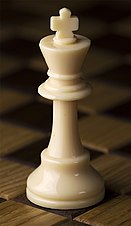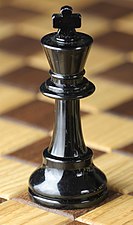King (chess)
Theking(♔, ♚) is the most importantpiecein the game ofchess.It may move to any adjoining square; it may also perform, in tandem with therook,a special move calledcastling.If a player's king is threatened with capture, it is said to beincheck,and the player must remove the threat ofcaptureimmediately. If this cannot be done, the king is said to be incheckmate,resulting in a loss for that player. A player cannot make any move that places their own king in check. Despite this, the king can become a strong offensive piece in theendgameor, rarely, themiddlegame.
Inalgebraic notation,the king is abbreviated by the letterKamong English speakers. The white king starts the game on e1; the black king starts on e8. Unlike all other pieces, each player can have only one king, and the kings are never removed from the board during the game.
Placement and movement[edit]
Initial placement of the kings
|
Possible movements of an unhindered king
|
The king's movement may be hindered by other pieces. Black's king cannot move to squares under attack by the white bishop, knight, rook, queen, or pawn; White's king cannot move to squares under attack by the black queen.
| ||||||||||||||||||||||||||||||||||||||||||||||||||||||||||||||||||||||||||||||||||||||||||||||||||||||||||||||||||||||||||||||||||||
The white king starts on e1, on the firstfileto the right of thequeenfrom White's perspective. The black king starts on e8, directly across from the white king. Each king starts on a square opposite its own color.
A king can move one square horizontally, vertically, and diagonally unless the square is already occupied by a friendly piece or the move would place the king in check. If the square is occupied by an undefended enemy piece, the king may capture it, removing it from play. Opposing kings may never occupy adjacent squares (seeopposition) to give check, as that would put the moving king in check as well. The king can givediscovered check,however, by unblocking abishop,rook,or queen.
Castling[edit]
| a | b | c | d | e | f | g | h | ||
| 8 |  | 8 | |||||||
| 7 | 7 | ||||||||
| 6 | 6 | ||||||||
| 5 | 5 | ||||||||
| 4 | 4 | ||||||||
| 3 | 3 | ||||||||
| 2 | 2 | ||||||||
| 1 | 1 | ||||||||
| a | b | c | d | e | f | g | h | ||
The king can make a special move, in conjunction with a rook of the same color, calledcastling.When castling, the king moves two squares horizontally toward one of its rooks, and that rook is placed on the square over which the king crossed.
Castling is permissible under the following conditions:
- Neither the king nor the castling rook have previously moved.
- No squares between the two pieces are occupied.
- The king is not in check.
- None of the squares the king would move across or to are under enemy attack.
Castling with the h-file rook is known ascastling kingsideorshort castling(denoted 0-0 inalgebraic notation), while castling with the a-file rook is known ascastling queensideorlong castling(denoted 0-0-0).
Status in games[edit]
Check and checkmate[edit]
| a | b | c | d | e | f | g | h | ||
| 8 |  | 8 | |||||||
| 7 | 7 | ||||||||
| 6 | 6 | ||||||||
| 5 | 5 | ||||||||
| 4 | 4 | ||||||||
| 3 | 3 | ||||||||
| 2 | 2 | ||||||||
| 1 | 1 | ||||||||
| a | b | c | d | e | f | g | h | ||
A king that is under attack is said to beincheck,and the player in check must immediately remedy the situation. There are three possible ways to remove the king from check:
- The king is moved to an adjacent non-threatened square. A player may not castle to get their king out of check. A king can capture an adjacent enemy piece if that piece is not protected by another enemy piece.
- A piece is interposed between the king and the attacking piece to break the line of threat (not possible when the attacking piece is aknightorpawn,or when indouble check).
- The attacking piece is captured (not possible when in double check, unless the king captures).
If none of the three options are available, the player's king has beencheckmated,and the player loses the game.
In casual games, when placing the opponent's king in check, it is common to announce "check", but this is not required by the rules of chess.
Stalemate[edit]
| a | b | c | d | e | f | g | h | ||
| 8 |  | 8 | |||||||
| 7 | 7 | ||||||||
| 6 | 6 | ||||||||
| 5 | 5 | ||||||||
| 4 | 4 | ||||||||
| 3 | 3 | ||||||||
| 2 | 2 | ||||||||
| 1 | 1 | ||||||||
| a | b | c | d | e | f | g | h | ||
A stalemate occurs when a player, on their turn, has no legal moves, and the player's king is not in check.
If this happens, the king is said to have been stalemated, and the game ends in adraw.A player who has very little or no chance of winning will often, in order to avoid a loss, try to entice the opponent to inadvertently place the player's king in stalemate (seeswindle).
Role in gameplay[edit]
In theopeningandmiddlegame,the king will rarely play an active role in the development of an offensive or defensive position. Instead, it will normallycastleand seek safety on the edge of the board behind friendlypawns.In theendgame,however, the king emerges to play an active role as an offensive piece, and can assist in thepromotionof the player's remaining pawns.
It is not meaningful to assign a value to the king relative to the other pieces, as it cannot be captured orexchangedand must be protected at all costs. In this sense, its value could be considered infinite. As an assessment of the king's capability as an offensive piece in the endgame, it is often considered to be slightly stronger than a bishop or knight.Emanuel Laskergave it the value of a knight plus apawn(i.e. four points on the scale ofchess piece relative value),[1]though some other theorists evaluate it closer to three points. It is better at defending friendly pawns than the knight is, and it is better at attacking enemy pawns than the bishop is.[2]
History[edit]

The king's predecessor is the piece of the same name inshatranj.Like the modern king, it is the most important piece in the game and can move to any neighboring square. However, in shatranj, baring the king is a win unless the opponent can do the same immediately afterward; stalemating the king is a win; and castling does not exist.
Name translations[edit]
| Language
|
King | Translation |
|---|---|---|
| Afrikaans | KKoning | king |
| Albanian | MMbreti | king |
| Arabic | ممَلِك (malik) | king |
| Azerbaijani | ŞŞah | shah |
| Armenian | ԱԱրքա (Ark῾a) | king |
| Basque | EErregea | king |
| Belarusian(Taraškievica) | Ккароль | king |
| Bengali | Rরাজা (rājā) | King |
| Bulgarian | Ццар | tsar |
| Catalan | Rrei | |
| Chinese | KVương(wáng) | king |
| Czech | Kkrál | king |
| Danish | Kkonge | king |
| Dutch | Kkoning | king |
| English | Kking | |
| Esperanto | Rreĝo | king |
| Estonian[3] | Kkuningas | king |
| Finnish | Kkuningas | king |
| French | Rroi | king |
| Galician | Rrei | king |
| Georgian | მფმეფე (mep'e) | king |
| German[4] | KKönig | king |
| Greek | Ρβασιλιάς (vasiliás) | king |
| Hindi | Rराजा (rājā) | king |
| Hebrew | ממלך (Melech) | king |
| Hausa | Ssarki | king |
| Hungarian | Kkirály | king |
| Icelandic | Kkóngur | king |
| Ido | Rrejo | king |
| Indonesian | Rraja | king |
| Interslavic | Kkralj | king |
| Irish | Rrí | king |
| Italian | Rre | king |
| Japanese | Kキング (kingu) | |
| Javanese | Rraja | king |
| Kannada | ರಾರಾಜ (raaja) | king |
| Kazakh | Крпатша (patşa) | king |
| Korean | K킹 (king) | |
| Latin | Rrex | king |
| Latvian | Kkaralis | king |
| Lithuanian | Kkaralius | king |
| Lojban | Nanoltrunau | king |
| Luxembourgish | KKinnek | king |
| Macedonian | Kкрал | king |
| Malayalam | Kരാജാവ് (raajavu) | king |
| Marathi | Rराजा (rājā) | king |
| Mongolian | Нноён | noyan |
| Norwegian Bokmål | Kkonge | king |
| Norwegian Nynorsk | Kkonge | king |
| Odia | Kରଜା (rôja) | king |
| Oromo | ||
| Persian | ششاه | king |
| Polish | Kkról | king |
| Portuguese | Rrei | king |
| Romanian | Rrege | king |
| Russian | Кркороль (korol') | king |
| Scottish Gaelic | Rrigh | king |
| Serbo-Croatian | Kkralj (Ккраљ) | king |
| Northern Sotho | КKgoši | |
| Sicilian | Rre | king |
| Slovak | Kkráľ | king |
| Slovene | Kkralj | king |
| Spanish | Rrey | king |
| Swedish | Kkung | king |
| Tamil | Kஅரசன் (arasaṉ) | king |
| Telugu | రాజు (rāju) | king |
| Thai | ขขุน (khun) | king |
| Turkish | Ş/Kşah / kral | shah/king |
| Ukrainian | Kркороль (korol) | king |
| Urdu | بادشاہ(bādshāh) | |
| Vietnamese | Vvua | king |
| Welsh | Tteyrn / brenin | lord/king |
Unicode[edit]
Unicodedefines three codepoints for a king:
♔U+2654 White Chess King
♚U+265A Black Chess King
🨀U+1FA00 Neutral Chess King
See also[edit]
- Bare king
- Chess piece
- Finial– top of king, often a monarch's
- King and pawn versus king endgame
- King's graph
- Mann– the non-royal equivalent piece
- Opposition– technique of king facing king
- Staunton chess set
Notes[edit]
- ^(Lasker 1934:73)
- ^(Ward 1996:13)
- ^The Estonian chess terms were coined byAdo Grenzstein.
- ^"Handbook".fide.Retrieved22 March2019.
The pieces bear the names: Koenig, Dame, Turm, Laeufer, Springer, Bauer
References[edit]
- Barden, Leonard(1980),Play better chess with Leonard Barden,Octopus Books Limited, pp. 9, 11, 12,ISBN0-7064-0967-1
- Brace, Edward R. (1977),An Illustrated Dictionary of Chess,Hamlyn Publishing Group, p. 151,ISBN1-55521-394-4
- Hooper, David;Whyld, Kenneth(1996) [First pub. 1992], "king",The Oxford Companion to Chess(2nd ed.),Oxford University Press,pp. 200–01,ISBN0-19-280049-3
- Lasker, Emanuel(1934),Lasker's Chess Primer,Billings (1988 reprint),ISBN0-7134-6241-8
- Ward, Chris(1996),Endgame Play,Batsford,ISBN0-7134-7920-5
- FIDE Handbook: Laws of Chess
External links[edit]
- Fianchetto variation of the King’s Indian DefenceArchived2014-08-05 atarchive.today
- Piececlopedia: Kingby Fergus Duniho andHans Bodlaender,The Chess Variant Pages


